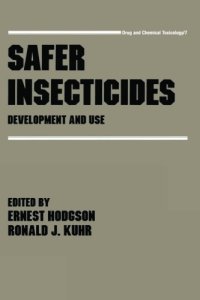
Ebook: Safer insecticides: development and use
Author: Hodgson Ernest, Kuhr Ronald J
- Tags: Insecticides, Insecticides--Physiological effect, Insecticides--Safety measures, TECHNOLOGY / Environmental Engineering & Technology, Electronic books, Insecticides -- Physiological effect, Insecticides -- Safety measures
- Series: Drug and chemical toxicology (New York N.Y. : 1984) 7
- Year: 2020
- Publisher: CRC Press
- City: Boca Raton
- Language: English
- pdf
Preface -- Contributors -- 1. Introduction /Ernest Hodgson and Ronald J. Kuhr -- I. Introduction -- II. Factors Involved in Insecticide Development -- III. Approaches to the Development of Safer Insecticides -- IV. Summary and Conclusions -- 2. Metabolism of Xenobiotics /W. C. Dauterman and Ernest Hodgson -- I. Introduction -- II. Phase-I Reactions -- III. Phase-II Reactions -- IV. Nutritional Effects on Xenobiotic Metabolism -- V. Physiological Effects on Xenobiotic Metabolism -- VI. Genetic Effects on Xenobiotic Metabolism -- VII. Chemical Effects on Xenobiotic Metabolism -- 3. Quantitative Structure-Activity Relationships of Insecticides /Keiichiro Nishimura, Haiime lwamura, and Toshio Fuiita -- I. Introduction -- II. Quantitative Analysis of Structure-Activity Relationships -- III. Approaches Toward Safer Insecticides -- IV. Concluding Remarks -- 4. Endocrine-Based Insecticides /Thomas C. Sparks -- I. Introduction -- II. Physiological Approaches to Insecticide Selectivity -- III. Approaches to Discovering New Insecticides -- IV. Exploiting the Insect Endocrine System -- V. Endocrine-Based Insecticides: Potential Modes of Action -- VI. Conclusions -- 5. Nervous-System-Based Insecticides /Mohyee E. Eldefrawi and Amira T. Eldefrawi -- I. Introduction -- II. Voltage-Dependent Ion Channels -- III. Neurotransmitter Receptors -- IV. Neurotransmitter Synthesis and Release -- V. Termination of Neurotransmitter Action -- VI. Concluding Remarks -- 6. Insecticides Based on Differences in Metabolic Pathways /Richard T. Mayer, G. Cunningham, and J. Gupton -- I. Introduction -- II. Chitin Synthesis Inhibitors -- III. Prostaglandins -- IV. Steroid Analogs as Insect Molting Hormone Inhibitors -- V. Conclusions -- 7. Inducers of Plant Resistance to Insects /Daniel C. Fischer, Marcos Kogan, and Patrick Greany -- I. Introduction -- II. Inducers of Plant Resistance or Susceptibility Against Insects -- III. Induction of Resistance by Growth Regulators, Plant Hormones, and Herbicides -- IV. Induction of Resistance by Previous Herbivory -- V. Potential Uses of Induced Resistance in Pest Management -- VI. Induced Resistance and Pest Management -- 8. Proinsecticides: Metabolically Activated Toxicants /Glenn D. Prestwich -- I. Fundamental Prodrug Concepts -- II. Proinsecticides as Prodrugs -- III. A Compendium of Proinsecticides -- IV. Future Design Strategies -- 9. Natural Products from Plants for the Control of Insect Pests /E. Arthur Bell, Linda E. Fellows, and -- Monique S. J, Simmonds -- I. Introduction -- II. Plant-Based Insecticides -- III. The Search for New Products -- IV. Toxins vs. Deterrents -- V. Insect Perception of Secondary Compounds -- VI. Plant Variability and Resistance to Insect Predation -- VII. Acquired Tolerance of Antiinsect Compounds in Specialist Feeders -- VIII. Conclusions -- 10. Viruses and Bacteria as Sources of Insecticides /C. Y. Kawanishi and C. A. Held -- I. Introduction -- II. Microbial Properties that Affect Pesticidal Use -- III. Viruses -- IV. Bacteria -- V. Biotechnology and the Future of Microbial Pesticides -- VI. Conclusions -- 11. Spider Toxins as Lead Structures for Novel Pesticides /Donald L. J. Quicke and Peter N. R. Usherwood -- I. Introduction -- II. Spider Taxonomy, Biology, and Toxinology -- III. Isolation and Chemical Characterization of Araneid Venoms -- IV. Neurophysiological Effects of Araneid -- Spider Venoms -- V. Conclusions -- 12. An Integrated Approach for Improvements in Application Technology /Franklin R. Hall -- I. Introduction -- II. Exposure Potentials with the Use of Agrichemicals -- III. Trends and Developments in Application Technology -- IV. Physics of Application -- V. Biological Requirements -- VI. Crop Protection Technology -- VII. Prospectus -- VIII. Future Needs -- IX. Conclusions -- 13. Improved Safety Through Reduction in Use of Existing Chemicals /A. M. Agnello and J. R. Bradley, Jr. -- I. Introduction -- II. Pesticide Reduction as a Result of New Approaches -- III. Pesticide Reduction as a Result of New Chemistry -- IV. Summary -- 14. Safety Considerations Relating to the Manufacture of Agrichemicals in the U.S. and the Third World Gustave /K. Kohn and Stephen J. Raab -- I. Introduction -- II. The Decision to Manufacture -- III. Cost-Benefit Analysis -- IV. Analytical Equipment and Its Upkeep -- V. Alternatives for Methyl Isocyanate and Phosgene -- VI. Chemical Aspects of Risk Reduction for the Manufacture of Carbamates (Urethanes) -- VII. Summary -- 15. Challenges: The Industrial Viewpoint /J. F. Engel, W. N. Harnish, and C. A. Staetz -- I. Introduction -- II. Market Considerations -- III. Industry Approaches -- IV. Constraints -- V. The Future -- Index.;Reference to the design of new insecticides nontoxic to the environment and the public emphasizing optimal food production with greater safety. Some 30 international experts examine topics including new types of active molecules among natural products and animal toxins; insect metabolic and organ sy
Download the book Safer insecticides: development and use for free or read online
Continue reading on any device:

Last viewed books
Related books
{related-news}
Comments (0)